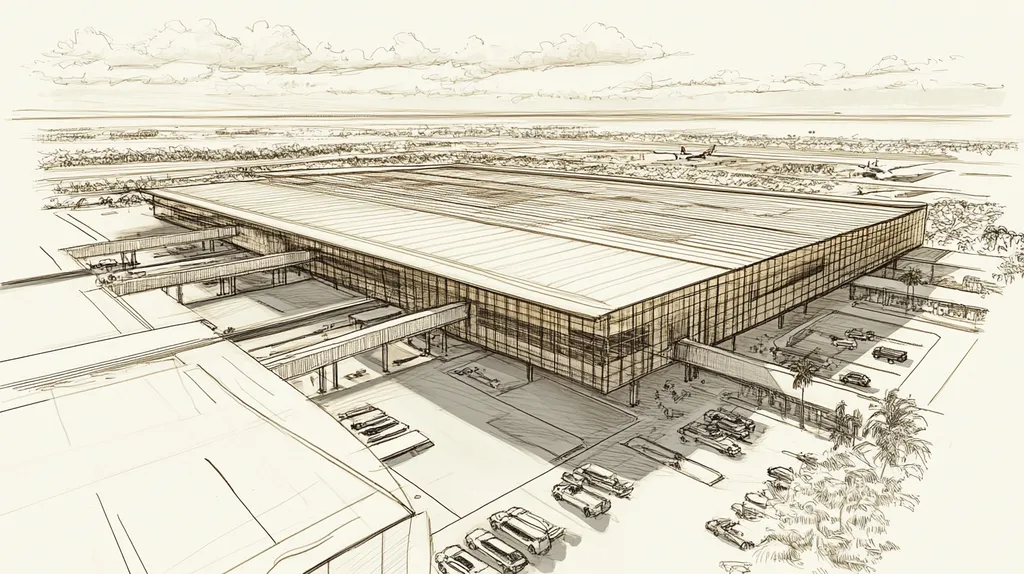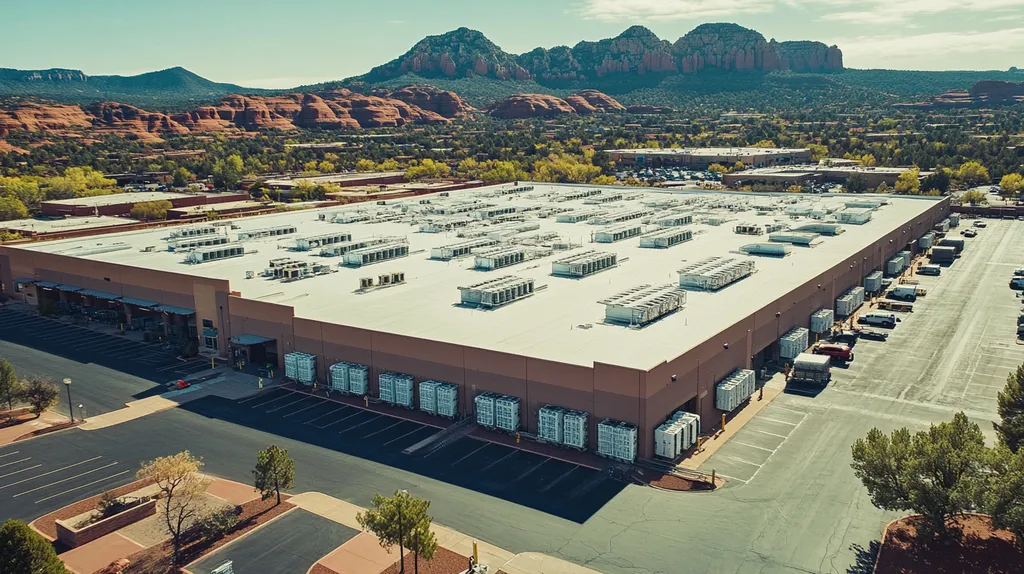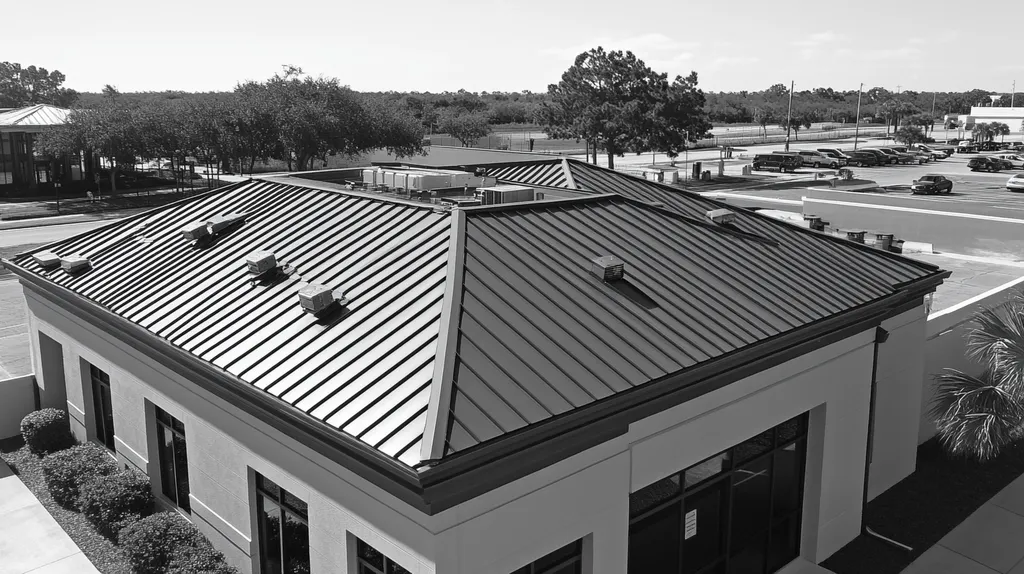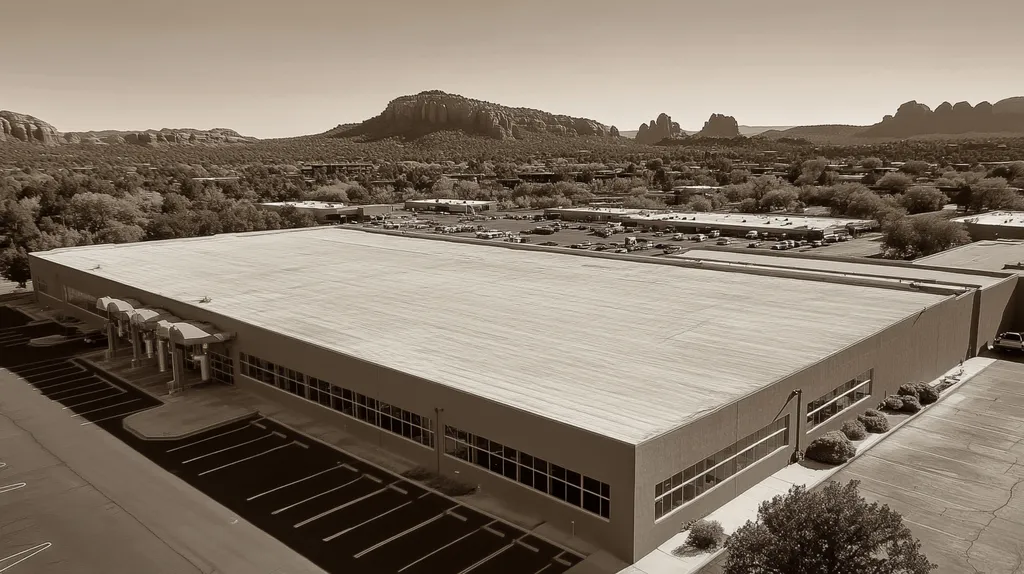The explosive growth of commercial solar installations – increasing 63% annually – has created an urgent challenge for property owners and facility managers: protecting their roofing investments while adopting renewable energy.
Industry data shows that poorly executed solar projects can cut roof lifespan in half, while optimal installations may extend it by up to 15 years.
This comprehensive guide examines the critical relationship between solar arrays and roof durability, from fundamental concepts through optimization strategies that ensure both systems work in harmony to maximize building performance and longevity.
SECTION 1: FUNDAMENTAL CONCEPTS
The commercial roofing industry stands at a critical crossroads as solar adoption accelerates. With solar installations on commercial buildings growing by over 60% annually, property owners face urgent decisions about protecting their roofing investments. Understanding the relationship between solar arrays and roof durability has become essential for maintaining building integrity and avoiding costly failures. This section examines the core principles of solar integration, its effects on roof performance, and the critical environmental factors that influence system longevity.
Solar Energy Basics and Roof Integration
Modern commercial solar installations represent a complex integration of energy generation and building protection systems. The success of any installation begins with a comprehensive evaluation of the existing roof structure, load-bearing capacity, and drainage patterns.
Mounting systems must distribute weight evenly across the roof while maintaining watertight integrity. Different roof types require specific attachment methods – from ballasted systems on flat roofs to penetrating mounts on pitched surfaces.
The orientation and pitch of panels significantly impact both energy production and roof stress points. South-facing installations typically generate optimal power, but roof structure must guide final placement decisions.
Proper integration requires careful attention to flashing details, penetration sealing, and maintaining adequate maintenance access. These elements ensure the roof continues its primary function of building protection while supporting energy generation.
Effects of Solar Panels on Roof Lifespan
Solar panels can extend roof durability when properly installed, with most systems lasting 25 to 30 years while protecting underlying roofing materials from direct environmental exposure. Quality materials and robust construction significantly influence this longevity, while environmental conditions and maintenance practices play crucial roles in system performance. (source: Roper Roofing and Solar)
The shade provided by panels can reduce thermal cycling stress on roofing materials. This protection often translates to slower degradation rates and extended service life for the underlying membrane or coating.
However, improper installation can create new vulnerabilities. Poorly sealed penetrations or inadequate flashing become potential water entry points, while misaligned mounting systems may cause uneven loading.
Regular inspection protocols must adapt to accommodate solar equipment, ensuring both systems receive appropriate maintenance attention throughout their service life.
Thermal and Environmental Impact on Roofs
Solar installations fundamentally alter a roof’s thermal dynamics. The air gap between panels and roofing surface creates a cooling effect, potentially reducing building cooling costs and membrane temperature fluctuations.
Wind uplift forces require special consideration with solar installations. Panel arrays can change air flow patterns across the roof surface, necessitating additional securing measures in some cases.
Snow and ice accumulation patterns shift with panel presence. Design must account for increased loads and potential drift patterns to prevent structural stress.
Water management becomes more complex with solar arrays present. Drainage paths require careful planning to prevent pooling around mounting points and maintain proper flow off the roof surface.
Temperature variations between shaded and exposed roof areas demand careful material selection. Membranes must maintain flexibility and performance across wider temperature ranges than traditional installations.
SECTION 2: SYSTEM COMPONENTS
The integration of solar arrays with commercial roofing systems demands careful attention to component selection and compatibility. With solar installations increasing by 40% annually in the commercial sector, choosing the wrong components can lead to premature roof failure and system underperformance. Understanding how these elements work together helps property owners protect their dual investment in roofing and renewable energy.
Photovoltaic Panel Types and Roofing Compatibility
Commercial rooftop solar installations typically utilize three main panel categories: monocrystalline, polycrystalline, and thin-film technologies. Each type presents distinct weight loads and installation requirements that directly impact roof performance.
Monocrystalline panels offer the highest efficiency in a compact footprint but add significant weight to the roof structure. Their rigid construction requires precise mounting solutions to maintain watertight integrity.
Polycrystalline panels provide a cost-effective middle ground, with moderate efficiency and weight considerations. Their larger surface area demands careful placement to maintain proper roof drainage patterns.
Thin-film panels present the lightest option but require more roof space for equivalent power generation. Their flexible nature can conform to various roof shapes but may need additional protection against wind uplift.
Mounting Systems and Roof Attachment Methods
Solar panels, when professionally installed with appropriate mounting systems, can actually enhance roof protection while generating clean energy. The key lies in selecting mounting systems that complement existing roof materials while maintaining structural integrity.
Ballasted systems distribute weight across the roof surface without penetrating the membrane. These systems excel on flat roofs with adequate load-bearing capacity but require careful spacing to prevent membrane compression.
Penetrating mounts offer superior wind resistance but demand precise flashing and weatherproofing at each attachment point. These installations create a permanent bond between the solar array and roof structure.
Hybrid mounting solutions combine ballast and penetrating elements to optimize stability while minimizing roof penetrations. This approach provides flexibility in addressing unique roof conditions and local wind load requirements. (source: Coldwell Solar)
Electrical Components and Roof Interface
The electrical infrastructure supporting solar arrays requires careful integration with roofing systems to prevent moisture infiltration and maintain system efficiency. Conduit runs, junction boxes, and inverter mounting locations must align with roof drainage patterns.
Inverter placement demands particular attention, as these components generate heat during operation. Adequate spacing from roof surfaces prevents temperature-related stress on roofing materials.
Cable management systems must secure wiring while allowing for thermal expansion and maintenance access. Proper routing prevents mechanical wear on both electrical components and roof surfaces.
Weatherproof enclosures protect electrical connections while maintaining rooftop drainage patterns. Strategic placement of these components helps prevent water accumulation and potential roof damage.
SECTION 3: IMPLEMENTATION METHODS
The integration of solar installations with commercial roofing represents a critical challenge facing property owners today. Industry data shows that poorly executed solar installations reduce roof lifespan by up to 50% while proper implementation can extend it. Understanding correct implementation methods has become essential as commercial solar adoption accelerates, with over 5,000 new installations completed monthly across the U.S. Success hinges on thorough assessment, protective installation practices, and strict adherence to structural requirements.
Pre-Installation Roof Assessment and Preparation
A comprehensive roof evaluation forms the foundation of successful solar integration. This assessment must examine current roof condition, remaining service life, drainage patterns, and structural capacity.
Core samples and moisture surveys identify existing issues that could compromise both roofing and solar systems. Early detection allows for targeted repairs before installation begins.
Documentation of existing conditions, including detailed photographs and infrared scans, establishes a baseline for future reference. This record proves invaluable for warranty claims and maintenance planning.
Load calculations must account for both dead loads from equipment and live loads from maintenance activities. These calculations inform mounting system selection and placement strategies.
Installation Best Practices to Protect Roofing
In most cases, proper mounting system selection prevents roof damage while maintaining structural integrity. Ballast-mounted systems that avoid membrane penetration offer superior protection for many commercial applications. (source: Catalyst Power Blog)
Walkway installation creates designated maintenance paths that protect surrounding roof areas. These pathways should align with panel layout to facilitate regular inspection and cleaning.
Weather monitoring during installation prevents moisture infiltration. Teams must maintain proper coverage and cease work when conditions threaten roof integrity.
Quality control protocols should verify proper flashing, sealing, and attachment methods throughout installation. Each connection point requires inspection before project completion.
Structural Load Considerations and Code Compliance
Building codes establish minimum requirements for both static and dynamic loading. These standards account for equipment weight, snow accumulation, and wind forces acting on panel arrays.
Structural analysis must evaluate the combined effects of existing roof loads and new solar equipment. This assessment determines necessary reinforcement or load distribution modifications.
Wind uplift calculations require special attention with solar installations. Panel arrays can create new pressure zones that affect roof system performance.
Local jurisdictions may impose additional requirements beyond basic building codes. Compliance documentation should address both general standards and location-specific regulations.
Regular structural inspections following installation ensure ongoing safety and performance. These evaluations should occur at least annually and after significant weather events.
SECTION 4: MAINTENANCE REQUIREMENTS
Maintaining integrated solar and roofing systems requires a sophisticated approach that directly impacts both energy generation and building protection. Industry data shows that poorly maintained solar installations can reduce system efficiency by up to 25% while simultaneously accelerating roof deterioration. With commercial solar installations representing significant capital investments, protecting these assets through proper maintenance has become a critical priority for facility managers.
Routine Roof and Panel Inspection Protocols
Comprehensive inspection programs must address both roofing components and solar equipment through coordinated evaluations. Monthly visual assessments should focus on obvious damage, while quarterly detailed inspections examine mounting systems, drainage patterns, and electrical connections.
Digital documentation including thermal imaging and moisture mapping provides essential trending data for predictive maintenance. These records help identify developing issues before they compromise system integrity.
Panel performance monitoring through data acquisition systems offers early warning of potential physical problems. Sudden efficiency drops often indicate mechanical issues requiring immediate investigation.
Seasonal inspections must account for specific environmental challenges like snow loading in winter and UV degradation in summer. This targeted approach helps maintain system resilience year-round.
Cleaning and Debris Management for Solar Arrays
Professional cleaning protocols balance maximum energy production with protection of sensitive roof materials. Scheduling should align with local environmental conditions, typically requiring 2-4 cleanings annually.
Temperature fluctuations between panels and mounting systems require careful debris management to prevent stress damage. The repeated expansion and contraction of materials demands consistent removal of accumulated dirt and organic matter. (source: Moser Baer Solar)
Drainage paths around mounting points need particular attention to prevent water damming. Regular clearing of these areas protects against moisture infiltration and premature material aging.
Safe cleaning practices must protect both maintenance personnel and roof surfaces. Using appropriate equipment and methods prevents damage while ensuring thorough debris removal.
Managing Roof Penetration and Waterproofing Integrity
Penetration points require systematic inspection and maintenance to preserve waterproof integrity. Monthly visual checks should examine sealants, flashings, and mounting hardware for signs of deterioration.
Preventive maintenance schedules must include regular resealing of critical junctions. This proactive approach helps avoid costly water damage and system downtime.
Movement monitoring at penetration points identifies potential stress areas before failure occurs. Tracking these changes enables targeted reinforcement where needed.
Emergency response protocols should prioritize penetration repairs during severe weather events. Quick action prevents minor issues from escalating into major structural problems.
SECTION 5: PERFORMANCE METRICS
Performance metrics have become critical as commercial solar installations transform roofing systems. Recent industry data shows that improper monitoring leads to a 40% increase in premature roof failures within the first five years after solar installation. Understanding and tracking key performance indicators helps property owners protect both their roofing investment and solar energy assets while maximizing building efficiency.
Monitoring Solar Energy Output and Efficiency
Real-time monitoring systems provide essential data about solar array performance through automated sensors and software platforms. These tools track power generation, panel efficiency, and system losses across different operating conditions.
Performance ratio calculations compare actual energy output against theoretical maximum generation. This metric helps identify underperforming components and potential maintenance needs before they impact roof integrity.
Weather station integration allows for correlation between environmental conditions and system output. Understanding these relationships helps optimize maintenance scheduling and protect roofing materials during extreme conditions.
Monthly performance reports should track degradation rates against manufacturer specifications. Accelerated efficiency losses often indicate mounting system issues that could compromise roof durability.
Roof Condition Metrics Post Solar Installation
PV installations create new stress points on commercial roofs through penetrations and additional loading. Regular assessment of these areas becomes critical for maintaining waterproofing integrity and structural stability.
Moisture mapping and infrared scanning help detect water infiltration before visible damage occurs. These technologies identify potential failure points around mounting systems and electrical penetrations.
Dynamic load monitoring tracks the impact of wind forces and thermal movement on roof assemblies. PV installations can add over 12,000 pounds of static load while creating new wind pressure patterns across the roof surface. (source: Building Enclosure Online)
Deflection measurements around mounting points help identify insulation compression or structural weakness. Regular monitoring prevents small issues from escalating into major structural concerns.
Impact of Solar Systems on Building Energy Use
Energy consumption patterns shift significantly after solar installation, requiring careful monitoring of both generation and usage. Tracking these changes helps optimize system performance while protecting roof integrity.
Peak demand reduction metrics demonstrate how effectively solar arrays offset building loads. This data influences decisions about panel placement and roof membrane selection.
Thermal performance monitoring ensures that solar installations don’t compromise roof insulation values. Temperature sensors track heat flow patterns and identify areas of reduced efficiency.
Cost-benefit analysis should incorporate both energy savings and roof maintenance expenses. This holistic approach helps property owners maximize return on investment while maintaining building protection.
SECTION 6: OPTIMIZATION STRATEGIES
Solar installations on commercial roofs represent a $4.2 billion annual market, yet 40% of these projects experience premature roof deterioration due to poor optimization. The stakes are high – a properly integrated solar system can extend roof life by 15 years, while poor implementation can cut it in half. Strategic optimization of both systems has become essential as commercial properties face increasing pressure to adopt renewable energy while maintaining building integrity.
Enhancing Roof Durability via Protective Solar Design
PV installations create significant pressure points on commercial roofs through both static and dynamic loading. A typical 100kW system adds over 12,000 pounds of weight, requiring careful distribution to prevent membrane damage and insulation compression. (source: Building Enclosure Online)
Strategic panel placement must account for existing roof stress points and drainage patterns. Maintaining clear paths for water flow prevents ponding while enabling proper system maintenance.
Reinforced walkways and service paths protect roof surfaces during installation and maintenance. These designated access routes should align with panel layout to minimize traffic impact on unprotected areas.
Enhanced insulation and membrane selection can offset the thermal impacts of solar arrays. High-performance materials maintain flexibility and durability despite changed temperature patterns beneath panels.
Fire Safety and Risk Mitigation in Solar Installations
Fire-resistant roofing materials and proper electrical component isolation form the foundation of solar safety. Class A fire-rated assemblies provide crucial protection against both external and internal ignition sources.
Dedicated rapid shutdown systems enable emergency responders to de-energize arrays quickly. This capability proves essential during fire events or urgent maintenance situations.
Regular thermal imaging inspections identify potential hot spots before they become hazards. Monthly scans of electrical connections and junction boxes catch developing issues early.
Clear labeling and access paths help fire crews navigate solar arrays safely. Emergency response plans must detail panel locations, shutoff procedures, and safe approach routes.
Planning for Long-Term Roof and Solar System Synergy
Coordinated maintenance schedules maximize efficiency while minimizing roof traffic. Combined inspections reduce repeated membrane stress while ensuring both systems receive proper attention.
Performance monitoring systems should track both energy generation and roof condition metrics. Integrated data collection helps identify potential issues before they impact either system.
Expansion planning must consider future roofing needs alongside solar capacity growth. Leaving designated areas for repairs and system upgrades prevents crowded installations that compromise maintenance access.
Documentation protocols should capture installation details, maintenance history, and system modifications. These records prove invaluable when planning upgrades or troubleshooting issues years after initial installation.
Looking Ahead
As commercial solar installations surge 63% annually, the intersection of roofing durability and renewable energy has reached a critical turning point.
The data is clear: properly integrated solar arrays can extend roof life by up to 15 years while poorly executed installations cut it in half, representing millions in potential losses or savings.
Success requires a comprehensive approach integrating proper component selection, professional installation methods, and rigorous maintenance protocols.
Forward-thinking facility managers must prioritize both systems’ long-term performance through dedicated monitoring, preventive maintenance, and strategic optimization.
The future of commercial roofing is intrinsically linked to solar adoption – those who master this integration will realize significant competitive advantages in both building protection and energy efficiency.
FREQUENTLY ASKED QUESTIONS
Q. How does solar energy affect commercial roof durability?
A. Solar panels can enhance roof durability by protecting materials from harsh environmental exposure. However, if installed poorly, they can create vulnerabilities that lead to damage. Regular maintenance and proper installation are key to maximizing the benefits.
Q. What impact do mounting systems have on an industrial roof?
A. Mounting systems must be compatible with the roofing materials and designed to distribute weight evenly. Poorly designed systems can lead to structural damage and a compromised roof, so choosing the right installation method is critical.
Q. What should I check before installing solar on my commercial roof?
A. A thorough roof assessment is essential to evaluate its condition, loading capacity, and drainage patterns. Identifying any existing issues beforehand allows for repairs that ensure successful solar integration and protect your investment.
Q. How often should a commercial roof with solar panels be inspected?
A. It’s advisable to conduct inspections monthly and more detailed assessments quarterly. Regular evaluations help identify any emerging issues with both the solar array and the roofing system, allowing for timely maintenance and preventing serious damage.
Q. Can solar panels increase my roof’s cooling efficiency?
A. Yes, the air gap between solar panels and the roofing material can improve cooling by reducing temperature fluctuations. This effect can lower cooling costs as the roof remains insulated from direct sunlight, benefiting overall energy efficiency.
Q. How do I maintain waterproof integrity after solar installation?
A. Regularly inspect and maintain the flashing and sealants around penetrations to ensure they remain effective. Scheduling proactive maintenance can prevent moisture infiltration, protecting both the solar system and the underlying roofing materials.
Q. What should I know about the lifespan of solar panels on an industrial roof?
A. Solar panels typically last between 25 to 30 years, extending the underlying roof’s durability when installed correctly. It’s crucial to monitor their performance and the roof’s condition to minimize long-term repair costs and maximize energy generation.









